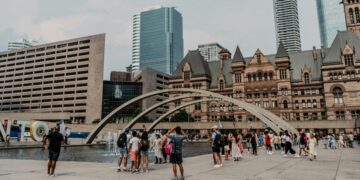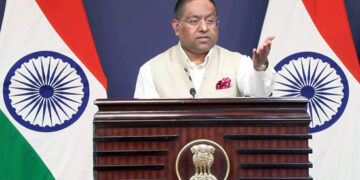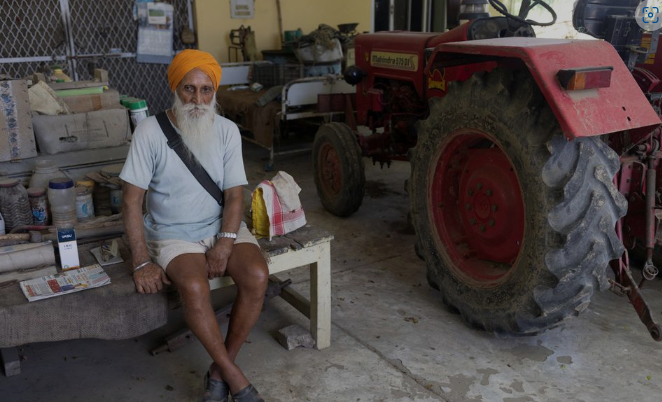The dispute centers around the murder of Hardeep Singh Nijjar in British Columbia in June, and Canadian Prime Minister Justin Trudeau’s subsequent comments suggesting the potential involvement of Indian government agents. India has vehemently denied any links to the alleged murder.
While the diplomatic row has primarily played out on the global stage, it has raised concerns among Sikhs in Punjab. Some members of the community are apprehensive about facing potential repercussions from India’s Hindu-nationalist government, known for its strong stance against Sikh separatism.
Sikh separatism has deep historical roots in Punjab, with a history of violence and insurgency that reached its peak in the 1980s and 1990s. The separatist movement sought the creation of an independent Sikh state called Khalistan, leading to a prolonged conflict in the region.
In recent years, Punjab has enjoyed relative peace, and the demand for Khalistan has largely waned in the region. However, the specter of separatism continues to haunt some Sikhs living in Canada and other countries.
The diplomatic dispute between India and Canada has added a layer of complexity to this issue. Sikhs in Punjab now face a dual dilemma – the fear of a backlash from India’s government and potential threats to their aspirations for a better life in North America.
Canada is home to a significant Sikh population, with Punjab being the largest source of foreign-born Sikh immigrants. The ties between the two regions run deep, with many Sikhs maintaining strong connections to their homeland.
As the diplomatic row continues, Sikhs in Punjab hope for a resolution that does not rekindle the flames of separatism. The issue has drawn international attention, with countries like the United States expressing concern, as both India and Canada grapple with the delicate balance between diplomacy and addressing the grievances of their Sikh communities.
The dispute’s ripple effects in Punjab serve as a stark reminder of the enduring challenges and complexities tied to Sikh separatism, even in a region that has largely moved beyond its violent past. As diplomatic negotiations continue, the fate of Sikhs in Punjab remains intertwined with the outcome of this international dispute.
The dispute centers around the murder of Hardeep Singh Nijjar in British Columbia in June, and Canadian Prime Minister Justin Trudeau’s subsequent comments suggesting the potential involvement of Indian government agents. India has vehemently denied any links to the alleged murder.
While the diplomatic row has primarily played out on the global stage, it has raised concerns among Sikhs in Punjab. Some members of the community are apprehensive about facing potential repercussions from India’s Hindu-nationalist government, known for its strong stance against Sikh separatism.
Sikh separatism has deep historical roots in Punjab, with a history of violence and insurgency that reached its peak in the 1980s and 1990s. The separatist movement sought the creation of an independent Sikh state called Khalistan, leading to a prolonged conflict in the region.
In recent years, Punjab has enjoyed relative peace, and the demand for Khalistan has largely waned in the region. However, the specter of separatism continues to haunt some Sikhs living in Canada and other countries.
The diplomatic dispute between India and Canada has added a layer of complexity to this issue. Sikhs in Punjab now face a dual dilemma – the fear of a backlash from India’s government and potential threats to their aspirations for a better life in North America.
Canada is home to a significant Sikh population, with Punjab being the largest source of foreign-born Sikh immigrants. The ties between the two regions run deep, with many Sikhs maintaining strong connections to their homeland.
As the diplomatic row continues, Sikhs in Punjab hope for a resolution that does not rekindle the flames of separatism. The issue has drawn international attention, with countries like the United States expressing concern, as both India and Canada grapple with the delicate balance between diplomacy and addressing the grievances of their Sikh communities.
The dispute’s ripple effects in Punjab serve as a stark reminder of the enduring challenges and complexities tied to Sikh separatism, even in a region that has largely moved beyond its violent past. As diplomatic negotiations continue, the fate of Sikhs in Punjab remains intertwined with the outcome of this international dispute.
The dispute centers around the murder of Hardeep Singh Nijjar in British Columbia in June, and Canadian Prime Minister Justin Trudeau’s subsequent comments suggesting the potential involvement of Indian government agents. India has vehemently denied any links to the alleged murder.
While the diplomatic row has primarily played out on the global stage, it has raised concerns among Sikhs in Punjab. Some members of the community are apprehensive about facing potential repercussions from India’s Hindu-nationalist government, known for its strong stance against Sikh separatism.
Sikh separatism has deep historical roots in Punjab, with a history of violence and insurgency that reached its peak in the 1980s and 1990s. The separatist movement sought the creation of an independent Sikh state called Khalistan, leading to a prolonged conflict in the region.
In recent years, Punjab has enjoyed relative peace, and the demand for Khalistan has largely waned in the region. However, the specter of separatism continues to haunt some Sikhs living in Canada and other countries.
The diplomatic dispute between India and Canada has added a layer of complexity to this issue. Sikhs in Punjab now face a dual dilemma – the fear of a backlash from India’s government and potential threats to their aspirations for a better life in North America.
Canada is home to a significant Sikh population, with Punjab being the largest source of foreign-born Sikh immigrants. The ties between the two regions run deep, with many Sikhs maintaining strong connections to their homeland.
As the diplomatic row continues, Sikhs in Punjab hope for a resolution that does not rekindle the flames of separatism. The issue has drawn international attention, with countries like the United States expressing concern, as both India and Canada grapple with the delicate balance between diplomacy and addressing the grievances of their Sikh communities.
The dispute’s ripple effects in Punjab serve as a stark reminder of the enduring challenges and complexities tied to Sikh separatism, even in a region that has largely moved beyond its violent past. As diplomatic negotiations continue, the fate of Sikhs in Punjab remains intertwined with the outcome of this international dispute.
The dispute centers around the murder of Hardeep Singh Nijjar in British Columbia in June, and Canadian Prime Minister Justin Trudeau’s subsequent comments suggesting the potential involvement of Indian government agents. India has vehemently denied any links to the alleged murder.
While the diplomatic row has primarily played out on the global stage, it has raised concerns among Sikhs in Punjab. Some members of the community are apprehensive about facing potential repercussions from India’s Hindu-nationalist government, known for its strong stance against Sikh separatism.
Sikh separatism has deep historical roots in Punjab, with a history of violence and insurgency that reached its peak in the 1980s and 1990s. The separatist movement sought the creation of an independent Sikh state called Khalistan, leading to a prolonged conflict in the region.
In recent years, Punjab has enjoyed relative peace, and the demand for Khalistan has largely waned in the region. However, the specter of separatism continues to haunt some Sikhs living in Canada and other countries.
The diplomatic dispute between India and Canada has added a layer of complexity to this issue. Sikhs in Punjab now face a dual dilemma – the fear of a backlash from India’s government and potential threats to their aspirations for a better life in North America.
Canada is home to a significant Sikh population, with Punjab being the largest source of foreign-born Sikh immigrants. The ties between the two regions run deep, with many Sikhs maintaining strong connections to their homeland.
As the diplomatic row continues, Sikhs in Punjab hope for a resolution that does not rekindle the flames of separatism. The issue has drawn international attention, with countries like the United States expressing concern, as both India and Canada grapple with the delicate balance between diplomacy and addressing the grievances of their Sikh communities.
The dispute’s ripple effects in Punjab serve as a stark reminder of the enduring challenges and complexities tied to Sikh separatism, even in a region that has largely moved beyond its violent past. As diplomatic negotiations continue, the fate of Sikhs in Punjab remains intertwined with the outcome of this international dispute.








 India
India












